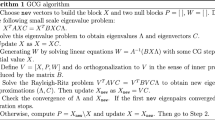Abstract
The authors propose software for the analysis and solution to the algebraic eigenvalue problem using an MIMD computer with GPUs, which includes parallel algorithms and programs with the functions of automatic adaptive configuration of the variable computer environment (multilevel parallelism, variable topology of interprocessor communications, mixed word length, caching, etc.) on the mathematical properties of the problem identified in the computer and the architectural features to ensure the reliability of the solution results and the efficient use of computing resources.
Similar content being viewed by others
References
I. V. Sergienko, I. N. Molchanov, and A. N. Khimich, “Intelligent technologies of high-performance computing,” Cybern. Syst. Analysis, Vol. 46, No. 5, 833–844 (2010). https://doi.org/https://doi.org/10.1007/s10559-010-9265-3.
I. V. Sergienko and A. N. Khimich, “ Mathematical modeling: From MESM to exaflops,” Visn. Nac. Akad. Nauk Ukr., No. 8, 37–50 (2019). https://doi.org/10.15407/visn2019.08.037.
J. Dongarra, P. Beckman, T. Moore, et al., “The International Exascale Software Project roadmap,” Int. J. High Perform. Comput. Appl., Vol. 25, Iss. 1, 3–60 (2011). https://doi.org/10.1177/1094342010391989.
A. N. Khimich, I. N. Molchanov, A. V. Popov, T. V. Chistyakova, and M. F. Yakovlev, Parallel Algorithms to Solve Problems in Computational Mathematics [in Russian], Naukova Dumka, Kyiv (2008).
O. V. Popov, O. V. Rudich, and O. V. Chystiakov, “Multi-level model of parallel computing for linear algebra problems,” Problems in Programming, No. 2–3, 83–92 (2018).
O. Popov and O. Chystiakov, “On the efficiency of algorithms with multi-level parallelism,” Physico-Mathematical Modelling and Informational Technologies, Issue 33, 133–137 (2021). https://doi.org/10.15407/fmmit2021.33.133.
O. V. Chistyakov, “Special features of software development to solve eigenvalue problems with sparse matrices by hybrid computers,” Komp. Matematika, No. 1, 75–84 (2015).
A. N. Khimich, V. À. Dekret, A. V. Popov, and A. V. Chistyakov, “numerical study of the stability of composite materials on computers of hybrid architecture,” J. Autom. Inform. Sci., Vol. 50, Iss. 7, 7–24 (2018). https://doi.org/10.1615/JAutomatInfScien.v50.i7.20.
O. M. Khimich, O. V. Chistyakov, and V. M. Brusnikin, “Hybrid algorithm of the generalized conjugate gradient method for the eigenvalue problem with symmetric sparse matrices,” Mathematical Machines and Systems, No. 3, 3–13 (2015).
A. N. Khimich, A. V. Popov, and O. V. Chistyakov, “Hybrid algorithms for solving the algebraic eigenvalue problem with sparse matrices,” Cybern. Syst. Analysis, Vol. 53, No. 6, 937–949 (2017). https://doi.org/https://doi.org/10.1007/s10559-017-9996-5.
O. M. Khimich, O. V. Popov, O. V. Chistyakov, and V. A. Sidoruk, “A parallel algorithm for solving a partial eigenvalue problem for block-diagonal bordered matrices,” Cybern. Syst. Analysis, Vol. 56, No. 6, 913–923 (2020). https://doi.org/https://doi.org/10.1007/s10559-020-00311-z.
I. N. Molchanov, A. V. Popov, and A. N. Khimich, “Algorithm to solve the partial eigenvalue problem for large profile matrices,” Cybern. Syst. Analysis, Vol. 28, No. 2, 281–286 (1992). https://doi.org/https://doi.org/10.1007/BF01126215.
“Message Passing Interface Forum. MPI: A Message-passing Interface Standard,” Int. J. High Perform. Comput. Appl., Vol. 8, No. 3/4, 157–414 (1994).
OpenMP. Architecture Review Board. URL: http://www.openmp.org/.
ÑUDA Toolkit 11.6 Update 2 Downloads. NVIDIA Developed. URL: https://developer.nvidia.com/cuda-downloads.
V. A. Sydoruk, P. S. Yershov, D. O. Bohurskyi, and O. R. Marochkanych, “Intellectualization of computation for mathematical modeling of complex processes and objects,” Komp. Matematika, No. 1, 143–150 (2019).
I. N. Molchanov, I. S. Levchenko, N. N. Fedonyuk, A. N. Khimich, and T. V. Chistyakova, “Numerical simulation of the stress concentration in an elastic half-space with a two-layer inclusion,” Int. Appl. Mech., Vol. 38, No. 3, 308–314 (2002). https://doi.org/https://doi.org/10.1023/A:1016078010683.
A. I. Lurie, Theory of Elasticity, Berlin–Heidelberg (2005).
E. Nikolaevskaya, A. Khimich, and T. Chistyakova, Programming with Multiple Precision, Ser. Studies in Computational Intelligence, Vol. 397, Springer, Berlin–Heidelberg (2012).
Î. Ì. Khimich, T. V. Chistyakova, V. A. Sidoruk, and P. S. Yershov, “Adaptive computer technologies for solving problems of computational and applied mathematics,” Cybern. Syst. Analysis, Vol. 57, No. 6, 990–997 (2021). https://doi.org/https://doi.org/10.1007/s10559-021-00424-z.
A. Buttari, J. Langou, J. Kurzak, and J. Dongarra, “A class of parallel tiled linear algebra algorithms for multicore architectures,” Parallel Computing, Vol. 35, Iss. 1, 38–53 (2009). https://doi.org/10.1016/j.parco.2008.10.002.
S. Pissanetzky, Sparse Matrix Technology, 1st ed., Elsevier (1984).
Y. Saad, Iterative Methods for Sparse Linear Systems, 2nd ed., SIAM (2003).
A. V. Popov, “Parallel algorithm for solving linear system with sparse symmetric matrices,” Probl. Programuv., No. 2–3, 111–118 (2008).
J. A. George and J. W-H. Liu, Computer Solution of Large Sparse Positive Definite Systems, Prentice-Hall Inc., Englewood Cliffs, NJ (1981).
B. N. Parlet, The Symmetric Eigenvalue Problem, SIAM (1998). https://doi.org/https://doi.org/10.1137/1.9781611971163.
O. V. Popov and O. V. Rudych, “On solving systems of linear equations on hybrid architecture computers,” Mathematical and Computer Modelling, Ser. Physical and Mathematical Sciences, Issue 15, 158–164 (2017).
SCIT Supercomputer of V. M. Glushkov Institute of Cybernetics, National Academy of Sciences of Ukraine. URL: http://icybcluster.org.ua.
The SuiteSparse Matrix Collection. URL: https://cise.ufl.edu/research/sparse/matrices.
Author information
Authors and Affiliations
Corresponding author
Additional information
Translated from Kibernetyka ta Systemnyi Analiz, No. 3, May–June, 2023, pp. 141–156
Rights and permissions
Springer Nature or its licensor (e.g. a society or other partner) holds exclusive rights to this article under a publishing agreement with the author(s) or other rightsholder(s); author self-archiving of the accepted manuscript version of this article is solely governed by the terms of such publishing agreement and applicable law.
About this article
Cite this article
Khimich, O.M., Popov, O.V., Chistyakov, O.V. et al. Adaptive Algorithms for Solving Eigenvalue Problems in the Variable Computer Environment of Supercomputers. Cybern Syst Anal 59, 480–492 (2023). https://doi.org/10.1007/s10559-023-00583-1
Received:
Published:
Issue Date:
DOI: https://doi.org/10.1007/s10559-023-00583-1




